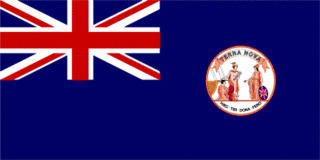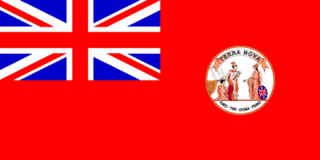At the outset, let's restate the point made in the original post which, admittedly, might have gotten lost either in the wake of the opening photo of a well-known Bowery Boy or in the end photo of Cameron Diaz.
The Gangs of St. John's argued that:
a. There are many more pressing issues deserving of widespread public debate or discussion at this point than what piece of coloured nylon flaps from the flagpoles of the province; and,
b. if we must discuss it, there is little merit in holding up the pink, white and green flag that derived from a particular, short-lived political faction in early 19th century St. John's as being somehow the de facto emblem of our fair land and its people.
The pink, white and green is a version of the flag of the so-called Newfoundland Natives' Society.
That is it. Pure and simple. After the Society collapsed in 1847, the flag appears periodically, almost exclusively in St. John's and continues today having become associated with the idea of Newfoundland and Labrador as an independent country.
The origins of the colour combination are somewhat difficult to trace. Prominent local historian John Fitzgerald brands as a fable the idea that the flag was designed to include the colours of England and Ireland with a white band of peace between the two. He then ignores any discussion of the origins of the flag, preferring instead, as does RGL to focus on the appearance of the flag after 1860 or thereabouts to make the case for the tricolour as the flag of this place. Oddly enough, the tricolour petition website actually cites the seal myth as part of the flag's history despite the fact that Fitzgerald dismisses it as unsubstantiated.
The Encyclopedia of Newfoundland and Labrador contends that the flag derived from the banners of two rival Irish organizations, one made up of people born in Newfoundland, the other being new-comers. This is the version I have accepted thus far, until someone can suggest an alternative.
There is no doubt that the tricolour appears periodically and has been held up as the local flag. However, the examples offered by O'Brien and others are almost exclusively from St. John's. O'Brien notes the formation of the police force and fire brigade, which, it should be noted means the St. John's police force and the St. John's fire brigade.
O'Brien notes the pledge of Sir Robert Bond in the 1908 election to make the tricolour the official flag of the country. He takes issue with my contention that Bond made the pledge for electoral benefit, likely by appealing to a particular group in St. John's (I am suggesting predominantly those of Irish heritage) to try and win a hotly contested election.
As I noted in comments on RGL, it seems passing strange that Bond would use the tricolour as a major part of his campaign. Bond was seeking re-election and it was during his administration that the legislature adopted a typical British ensign as the official flag of Newfoundland. Aside from what may have occurred in certain instances noted by tricolour supporters, this flag flew on all government buildings before 1949 and a blue ensign of the same design flew on government-owned vessels. It is also the flag that hangs in the Amiens memorial chapel to the fallen of the Great War representing Newfoundland, as one of the countries that fought to defend France.

The 1904 Newfoundland Ensign
Perhaps the most curious portion of O'Brien's post is the argument that I have somehow confused the tricolour flag with separatism. He cites a poll conducted for the Vic Young Royal Commission as proof of his contention that the flag and the "nationalist" sentiment actually pervade the province.
Let's us be clear. The Ryan Research poll does indicate that an overwhelming majority of respondents consider themselves to be Newfoundlanders or Labradorians before they consider themselves Canadians. At the same time, the poll also found that an overwhelming majority of respondents were opposed to Newfoundland and Labrador becoming an independent country. That sentiment was strong across all regions, including St. John's.
But at no point does Ryan ask about the flag. Therefore, O'Brien's use of this poll to prove or disprove any point about the validity of the tricolour as the provincial flag is erroneous.
Nationalism, on the other hand is something altogether different from independence and separatism. Nationalism as pride in one's place of birth is an obvious notion.
The "nationalism" to which I referred in The Gangs of St. John's is that version of nationalism that is rooted in St. John's. Part of it derives from the nativist sentiment of almost two centuries ago. Some of it - albeit a very small portion, according to Ryan - is unabashedly in favour of a return to so-called responsible government: independence.
To be fair, I should have clarified my use of the term. In local usage, the word "nationalist" almost invariable does not mean independence. Even the newspaper which uses the tricolour in its masthead and which calls itself The Independent cannot seem to call outright for the independence of Newfoundland and Labrador from Canada.
Rather the "nationalists", who have always been found mostly on the streets of St. John's are actually closer in philosophy to Quebec's sovereignists: they romanticize about local "nationalism", of being maitres chez nous, and speak in strong terms about the supposedly harsh treatment this place has received from "evil" Canadians.
Yet, these same champions of Newfoundland and Labrador seem to be unable to remove themselves from the tit on the Rideau. They studiously avoid working out the financial implications of separation. They argue for something akin to sovereignty-association, with progressively more and more political power accruing to St. John's while Ottawa has little to do beyond keeping the cash flowing to provincial coffers.
In that context, the January offshore deal is a classic example of the "nationalist" approach - so that the provincial government may receive all revenues from its offshore resources, it must receive not only all the revenues (as it currently does, and as acknowledged by the provincial government in the deal itself) but it must also receive federal transfer payments as if those revenues did not exist. We attain local self-determination (does this not mean independence?) - we become masters of our destiny in the Premier's words - by receiving ever more hand-outs from Uncle Ottawa.
That said, the pink, white and green is the banner around which these "nationalists" rally and no one should pretend that this tricolour flag is being proposed and is supported largely by anyone other than "nationalists".
Through it all, however, one cannot escape the overwhelming rejection of independence by those polled merely two years ago. The numbers today may well be different, but somehow I would doubt they would be radically different such that I might think it possible - were I a "nationalist" - to use an old St. John's flag as my rallying banner and expect to get very far.
This brings me inevitably back to the point at which The Gangs of St. John's started. With all the challenges faced by Newfoundlanders and Labradorians, surely the last thing on our agenda should be the flag. The last thing we ought bother to argue about should be the flag that is linked inextricably with such a small percentage of the population - by any measure.
If the flag - if the pink, white and green - is all we have to talk about or write petitions about, then surely we have reached a political dead end in Newfoundland and Labrador.
Maybe Satch really is the father of our "nationalists", if not our nation.
Let's us be clear. The Ryan Research poll does indicate that an overwhelming majority of respondents consider themselves to be Newfoundlanders or Labradorians before they consider themselves Canadians. At the same time, the poll also found that an overwhelming majority of respondents were opposed to Newfoundland and Labrador becoming an independent country. That sentiment was strong across all regions, including St. John's.
But at no point does Ryan ask about the flag. Therefore, O'Brien's use of this poll to prove or disprove any point about the validity of the tricolour as the provincial flag is erroneous.
Nationalism, on the other hand is something altogether different from independence and separatism. Nationalism as pride in one's place of birth is an obvious notion.
The "nationalism" to which I referred in The Gangs of St. John's is that version of nationalism that is rooted in St. John's. Part of it derives from the nativist sentiment of almost two centuries ago. Some of it - albeit a very small portion, according to Ryan - is unabashedly in favour of a return to so-called responsible government: independence.
To be fair, I should have clarified my use of the term. In local usage, the word "nationalist" almost invariable does not mean independence. Even the newspaper which uses the tricolour in its masthead and which calls itself The Independent cannot seem to call outright for the independence of Newfoundland and Labrador from Canada.
Rather the "nationalists", who have always been found mostly on the streets of St. John's are actually closer in philosophy to Quebec's sovereignists: they romanticize about local "nationalism", of being maitres chez nous, and speak in strong terms about the supposedly harsh treatment this place has received from "evil" Canadians.
Yet, these same champions of Newfoundland and Labrador seem to be unable to remove themselves from the tit on the Rideau. They studiously avoid working out the financial implications of separation. They argue for something akin to sovereignty-association, with progressively more and more political power accruing to St. John's while Ottawa has little to do beyond keeping the cash flowing to provincial coffers.
In that context, the January offshore deal is a classic example of the "nationalist" approach - so that the provincial government may receive all revenues from its offshore resources, it must receive not only all the revenues (as it currently does, and as acknowledged by the provincial government in the deal itself) but it must also receive federal transfer payments as if those revenues did not exist. We attain local self-determination (does this not mean independence?) - we become masters of our destiny in the Premier's words - by receiving ever more hand-outs from Uncle Ottawa.
That said, the pink, white and green is the banner around which these "nationalists" rally and no one should pretend that this tricolour flag is being proposed and is supported largely by anyone other than "nationalists".
Through it all, however, one cannot escape the overwhelming rejection of independence by those polled merely two years ago. The numbers today may well be different, but somehow I would doubt they would be radically different such that I might think it possible - were I a "nationalist" - to use an old St. John's flag as my rallying banner and expect to get very far.
This brings me inevitably back to the point at which The Gangs of St. John's started. With all the challenges faced by Newfoundlanders and Labradorians, surely the last thing on our agenda should be the flag. The last thing we ought bother to argue about should be the flag that is linked inextricably with such a small percentage of the population - by any measure.
If the flag - if the pink, white and green - is all we have to talk about or write petitions about, then surely we have reached a political dead end in Newfoundland and Labrador.
Maybe Satch really is the father of our "nationalists", if not our nation.
